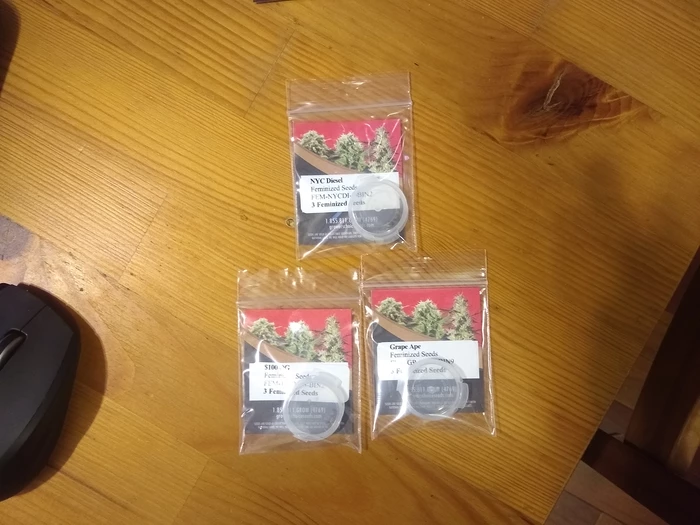
Saturday, August 28, 2021
My first time around I made all of the mistakes, and the plants died as seedlings.
This time, I will make different mistakes.
Start with the seeds.
Three strains:
I dropped the seeds into some tap water and waited for them to sprout. They all sprouted more or less after a couple of days, after which I planted each in a plastic cup of potting soil.
Before long, they all poked out of the soil and started reaching for the lights.
Well, one of them didn't. I went digging through the soil after a few days, and there was no evidence of the previously sprouted seed. There was, however, a very fat looking ant, who seemed relieved to be freed from the soil. She leapt from the side of the cup onto the kitchen counter and scurried towards the refrigerator and out of sight. Did she eat the young plant? Did I accidentally not plant that one? In any case, 8/9 ain't bad.
That's my stove. I bought a dowel, cut it to size with a hacksaw, and jammed it into the hood above my stove. That way I can hang "drop light" sockets from it, and screw in one of the million LED bulbs that I bought on Amazon a while back.
When I cook, I just move the plants onto the refrigerator until I'm done.
At first the plants were doing well; decent foliage and lots of roots.
Not long after, though, I started to notice brown spots on the leaves, burnt-looking tips, and general wasting in some plants. It seemed to get worse any time I'd water the plants. Was I over-watering again?
Google searches only revealed that these symptoms could be caused by anything, and that I should do something now, or else the plants will die, again.
So, I asked for help on reddit. Somebody replied with the following advice:
Ph your water. You’d want it to be between 6.5-7.
Also check if your city uses chloramine and chlorine in their water, which they most likely do. You’d either filter your water or use store bought.
Also, change to non-white cups. Light hitting the roots can damage them.
I’d also change the lighting schedule to 18/6 during veg.
Aha, maybe it's not the quantity of water but the quality.
Another possibility was that the plants had outgrown these cups, and were now near exhausting the available nutrients ("root-bound"). For plants this young in soil this rich, that is unlikely. Still, in addition to taking the redditor's advice, I also planned to transplant into larger containers.
Now I prepare the water for my plants in a pasta pot. Tap water goes in, gets boiled for about fifteen minutes, and then sits out overnight, or longer. Then I adjust the pH using pH test strips and tiny additions of either citric acid or potassium hydroxide. The redditor had a point: my tap water (pure though NYC tap water is reported to be) has a pH of around 8 and is full of chlorine. One pot of water lasts a long time, because don't over-water your plants.
Things were getting cramped growing everything on the stove. I have this storage space above my bathroom, let's use that instead.
I went to the local gardening store looking for cheap plastic pots about a gallon in volume. They don't sell cheap plastic pots (though every one of the hundreds of plants they sell is potted in one). They only sell terra cotta pots for $40 each.
I didn't buy any pots, but as luck would have it, somebody decided to throw away these plastic drawers on the curb right next to the gardening store:
The plants will be pretty cozy, but I think that will work! Just drill a bunch of holes in the bottom.
About an afternoon later, I had the plants transferred into the bins; one bin per strain.
Now for the lighting. At first I thought that I'd string the "drop lights" on thread like a clothesline, or maybe I'd use longer dowels. That would be a pain in the ass. Also, whatever I decide, it will need to accommodate future additions of more lights as the plants grow.
Then I found this cardboard box in my storage space:
I traced out socket-sized holes in the box and cut them out. The idea is that the cardboard will be a "roof" over the plants, with the bulbs coming in the top and pointing down onto the plants.
The weight of the light fixtures might make the cardboard collapse inward, though, so first I tied some chopsticks to the underside to resist the tendency of the box to bend downward.
I have plenty of aluminum foil, so let's add that to the underside, too.
Here's the setup with some bulbs in place:
The cardboard is supported on the right by the plastic shelving from which I took the drawers, and on the left by a wooden step stool that I also found on the curb the same day.
The power runs over the top of the setup and off to the side, where I have a power strip with a timer plugged into an extension cord that runs to the kitchen. Per the redditor's advice, I'm keeping the plants under light eighteen hours per day.
It's all a serious fire hazard. At least it's surge protected.
Here the plants are in place the day I set them up:
The fan on the right keeps a gentle breeze blowing over the plants at all times. The owls keep watch at night.
It's been a week since the transplant, and I think the plants might be recovering. It's hard to tell, because the nutrient deficiency is probably "mobile," meaning that the plant can prioritize healthy growth of new leaves, even as the death knell intensifies.
Here are some blurry pictures from today.
Hang in there, my little green ones!